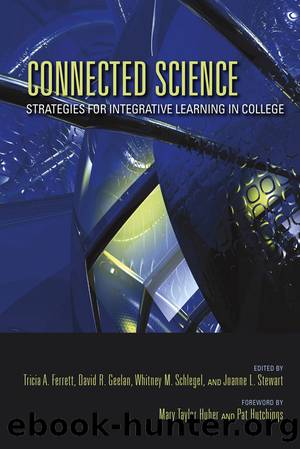Connected Science by unknow

Author:unknow
Language: eng
Format: epub
Publisher: Indiana University Press
Authentic Biology: Promoting Higher-Level Understanding
Both the team-based learning and SCALE-UP classroom approaches recognize the importance of moving the learning of basic knowledge, at the lowest two levels of Benjamin Bloomâs cognitive scale (Bloom et al., 1956), to outside of class. While basic knowledge is important, we accept the research findings on the limitations of lectures for conveying this information (Handelsman et al., 2006). Instead, we expect our students to learn the basic concepts from the text before the start of each course module. Class time then emphasizes application and analysis that promotes higher-level understanding. In both Biol2002 and Biol2003, traditional lecturing is typically less than one hour per week and is often conducted in short blocks interspersed with learning activities.
In the course, instructors engage students in distinct types of learning activities: âtangiblesâ (hands-on) and âponderablesâ (minds-on). Biological tangibles can be divided into those most suited for a âwetâ technology laboratory setting and those suited for the SCALE-UP classroomâs âdryâ technology environment. Biol2002 and Biol2003 have separate wet lab sections called âresearch labâ that allow students to do lab-based biology. For example, students use microscopes, carry out electrophoresis, and culture bacteria. In what normally would be called âlecture,â students engage in a âconcept lab,â a term borrowed from Daniel Udovicâs Workshop Biology (Udovic, 1996). Here, students work actively with data, simulations, case studies, and physical models. Ponderablesâpencil-and-paper problems, discussion questions, and case studies, for instanceâare also well suited for the SCALE-UP classroom where thinking like a biologist and in a team defines the learning.
In both semesters of our course, students also work on projects that span from four weeks to the entire semester. These projects provide students with the experience of doing the sustained intellectual work of a biologist. Students engage the primary literature, work collaboratively in a team at every stage, use evidence-based, persuasive scientific writing, and present their final work to peers at a poster session.
Although evaluation of projects requires carefully constructed rubrics that take significant time to develop, projects are very effective in getting students to think like scientists, to grapple with biological concepts at the highest of Bloomâs cognitive levels, and to integrate concepts from all sections of the course. For example, in the first term (Biol2002), students are charged with writing a proposal to create a genetically modified organism that would offer some social benefit. We make the semester-long project manageable by breaking it into stages on which we can give context-specific instruction, formative feedback, and a chance for interteam and interteam peer review. For the cell biology section of the Biol2003 course, the long-term project is a mini-grant proposal in which each team proposes two novel hypotheses regarding a transport protein, and designs experiments to test those hypotheses. Each team turns in a 15-page paper, excluding figures and references, organized like an actual grant proposal.
Download
This site does not store any files on its server. We only index and link to content provided by other sites. Please contact the content providers to delete copyright contents if any and email us, we'll remove relevant links or contents immediately.
Math in Minutes by Paul Glendinning(456)
Mastering Linear Algebra: A Comprehensive Guide to Learn Linear Algebra by Ltd Cybellium(218)
Effortlessly Perform Fast Mental Math: A comprehensive Guide for anyone willing to master mathematics in a simple and fun way by Syed Iqbal Shareef(167)
Alice in quantumland: an allegory of quantum physics by Robert Gilmore(162)
English for computer science rescuer by Unknown(157)
Mathematics of Financial Markets by Elliott(148)
A History of Chinese Mathematics by Jean-Claude Martzloff(147)
Regular Extensions of Hermitian Operators by A. V. Kuzhel; S. A. Kuzhel(134)
Numbers to Symbols: Strategies for Learning and Teaching Mathematics (Pre K - 8th Grade) by Su Hui Fang(132)
the snobol4 programming language 2ed by Unknown(114)
Connected Science by unknow(111)
A Primer of Higher Space [the Fourth Dimension] by Claude Fayette Bragdon(108)
Textbook of Endodontics by Unknown(107)
Generalized Functions, Volume V: Integral Geometry and Representation theory by I. M. Gel'fand; M. I. Graev; N. Ya. Vilenkin(105)
Karl Pearson's History of Statistics by Karl Pearson's History of Statistics(105)
Your Daily Math by Laura Laing(103)
Quantum Invariants of Knots and 3-Manifolds by Vladimir G. Turaev(103)
Assessing the Reliability of Complex Models by Committee on Mathematical Foundations of Verification Validation & Uncertainty Quantification(101)
Derived Manifolds from Functors of Points by Franz Vogler(99)
